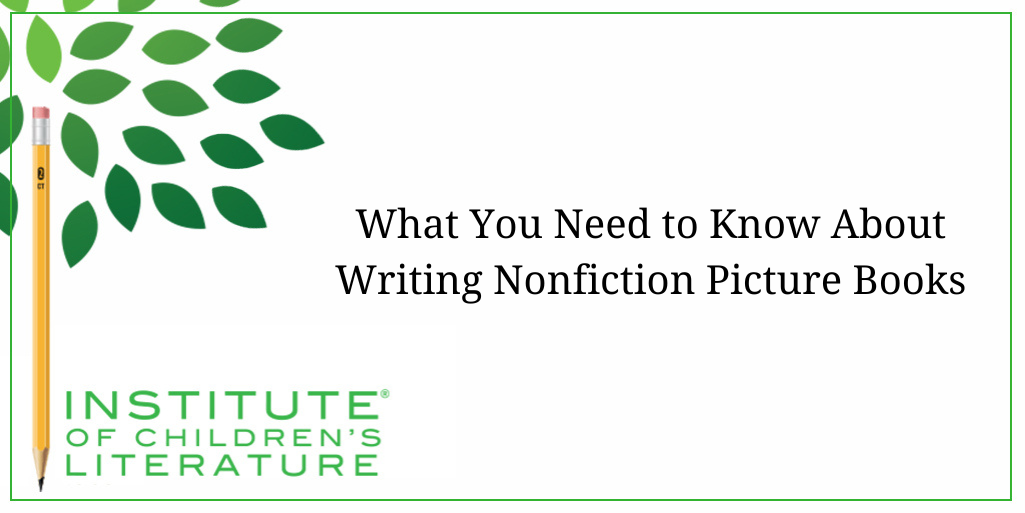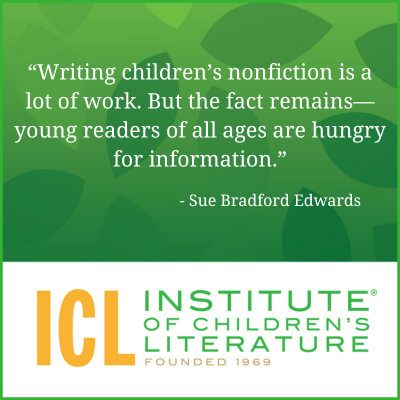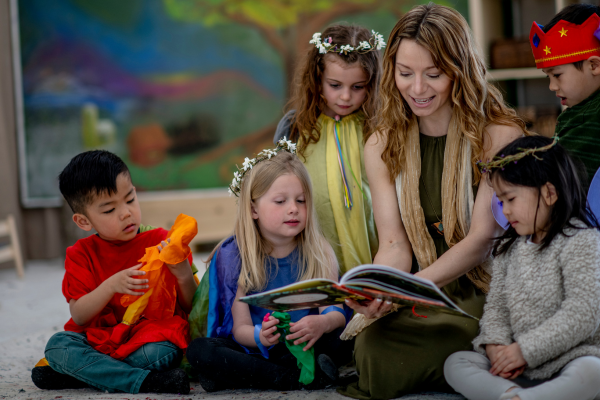
5 Ways Writers Can Prep for 2025 Goal Setting
Before we roll on to the new writing year, let’s harness our optimism for the blank slate before us and prepare for our 2025 Goal Setting just for writers.
Beginning Tuesday, July 22, 2025 at 10 PM CT through Wednesday, July 23, 2025 at 4 AM CT, we will be performing scheduled maintenance to update our website.

 Consider this, from an essay by Scholastic Parents: “Reading nonfiction is about taking in new information, layering it on top of what you already know, and drawing insights from the connections you make to the new information. In other words, intake is proportionate to existing knowledge.”
This quote is about reading, but it contains concepts important for the writer of picture book nonfiction, namely that writers need to keep in mind existing knowledge the reader is likely to have and build the nonfiction on top of that. If you jump way ahead of what readers know then the reader will have no knowledge pool to draw on to understand and draw insights from the new information. In other words, you’ll simply confuse that reader. No learning will take place.
Consider this, from an essay by Scholastic Parents: “Reading nonfiction is about taking in new information, layering it on top of what you already know, and drawing insights from the connections you make to the new information. In other words, intake is proportionate to existing knowledge.”
This quote is about reading, but it contains concepts important for the writer of picture book nonfiction, namely that writers need to keep in mind existing knowledge the reader is likely to have and build the nonfiction on top of that. If you jump way ahead of what readers know then the reader will have no knowledge pool to draw on to understand and draw insights from the new information. In other words, you’ll simply confuse that reader. No learning will take place.
 As the quote from Scholastic Parents suggested, you must consider the reader as much as you consider your own interests. You will need a topic that excites kids and about which they are likely to have enough existing knowledge that they can understand what you are presenting.
For example, young children often love books about vehicles, dinosaurs, sharks, and other scary animals. These topics are so popular that most children have a decent basic knowledge when they are still quite young. That means if you write a book about construction vehicles, you’re not going to need to explain basic things: that vehicles have wheels, drivers, and motors. Instead, you can begin by assuming basic knowledge and go further with the new things you bring to the subject.
Keep in mind that topics that are popular with children also have many books already in print. If you want to write a book about scary animals, you’ll need to include research into what scary animal picture books are already in print, so that you can find a way to make yours stand out. If you are writing something that has been done over and over, it may be harder to find a unique slant or new, unexplored areas that will make your book of interest to publishers and book buyers, but not impossible.
Another thing that can help a nonfiction book succeed is if it will interest teachers. Taking time to consider what topics are introduced in early primary grades can help you add that little bit of extra appeal. Or it can help you see how best to describe your book idea to publishers. Explaining how your book will interest teachers will make it interest publishers more too.
As the quote from Scholastic Parents suggested, you must consider the reader as much as you consider your own interests. You will need a topic that excites kids and about which they are likely to have enough existing knowledge that they can understand what you are presenting.
For example, young children often love books about vehicles, dinosaurs, sharks, and other scary animals. These topics are so popular that most children have a decent basic knowledge when they are still quite young. That means if you write a book about construction vehicles, you’re not going to need to explain basic things: that vehicles have wheels, drivers, and motors. Instead, you can begin by assuming basic knowledge and go further with the new things you bring to the subject.
Keep in mind that topics that are popular with children also have many books already in print. If you want to write a book about scary animals, you’ll need to include research into what scary animal picture books are already in print, so that you can find a way to make yours stand out. If you are writing something that has been done over and over, it may be harder to find a unique slant or new, unexplored areas that will make your book of interest to publishers and book buyers, but not impossible.
Another thing that can help a nonfiction book succeed is if it will interest teachers. Taking time to consider what topics are introduced in early primary grades can help you add that little bit of extra appeal. Or it can help you see how best to describe your book idea to publishers. Explaining how your book will interest teachers will make it interest publishers more too.
 Nonfiction picture book writers research until they are experts about the topic they intend to cover. Scant knowledge is not enough. Things you think you know are not enough. You need to deepen your knowledge obsessively in order to produce the best possible book.
That means you will read about your topic. You’ll read other fossil picture books, both because you want to be sure you know everything that’s been covered, but also because it will often give you a solid jumping-off point for your own research. But that’s not enough. You’ll also research academic works, casual books for adults, and articles on the web about your chosen topic.
Using the web to deepen your knowledge of a topic is a double-edged sword. You can find cutting-edge information on the web, but you can also find oceans of bad research and wrong information. You’ll find topics spun to suit the interests of companies or individuals. Develop a skeptic’s eye and a researcher’s passion for learning what is behind every bit of information you discover. Who said it? How did they know? How can I go closer to the original source of this information to be more certain?
As you read, collect questions that pop into your head and note points of interest so you can use them as guideposts to what you need to learn more about. Follow the rabbit trails, because they can take you to knowledge you didn’t even know you needed.
Nonfiction picture book writers research until they are experts about the topic they intend to cover. Scant knowledge is not enough. Things you think you know are not enough. You need to deepen your knowledge obsessively in order to produce the best possible book.
That means you will read about your topic. You’ll read other fossil picture books, both because you want to be sure you know everything that’s been covered, but also because it will often give you a solid jumping-off point for your own research. But that’s not enough. You’ll also research academic works, casual books for adults, and articles on the web about your chosen topic.
Using the web to deepen your knowledge of a topic is a double-edged sword. You can find cutting-edge information on the web, but you can also find oceans of bad research and wrong information. You’ll find topics spun to suit the interests of companies or individuals. Develop a skeptic’s eye and a researcher’s passion for learning what is behind every bit of information you discover. Who said it? How did they know? How can I go closer to the original source of this information to be more certain?
As you read, collect questions that pop into your head and note points of interest so you can use them as guideposts to what you need to learn more about. Follow the rabbit trails, because they can take you to knowledge you didn’t even know you needed.
 Your slant, or the specific piece of the overall topic that you intend to explore, will be honed by the goal. Consider the hypothetical book about fossils I mentioned above, Stone Bones. I won’t be describing the life cycle of dinosaurs. I won’t be talking about how different creatures appeared in different eras. Instead, I will stick to looking at how ancient creatures became the fossils that paleontologists discover today. My goal will be to give the reader a sense of how things can undergo astonishing changes over time, and I’ll do it through the specific exploration of how a dinosaur became a fossil bone. I may also look at fossil remains of creatures that never had bones, as that will be a rabbit trail that is closely enough related to my slant and my goal.
Your slant, or the specific piece of the overall topic that you intend to explore, will be honed by the goal. Consider the hypothetical book about fossils I mentioned above, Stone Bones. I won’t be describing the life cycle of dinosaurs. I won’t be talking about how different creatures appeared in different eras. Instead, I will stick to looking at how ancient creatures became the fossils that paleontologists discover today. My goal will be to give the reader a sense of how things can undergo astonishing changes over time, and I’ll do it through the specific exploration of how a dinosaur became a fossil bone. I may also look at fossil remains of creatures that never had bones, as that will be a rabbit trail that is closely enough related to my slant and my goal.
With over 100 books in publication, Jan Fields writes both chapter books for children and mystery novels for adults. She’s also known for a variety of experiences teaching writing, from one session SCBWI events to lengthier Highlights Foundation workshops to these blog posts for the Institute of Children’s Literature. As a former ICL instructor, Jan enjoys equipping writers for success in whatever way she can.

Before we roll on to the new writing year, let’s harness our optimism for the blank slate before us and prepare for our 2025 Goal Setting just for writers.

Writers can be thin-skinned when it comes to getting feedback on their work. Let’s look at 4 ways to positively deal with constructive criticism!

Rejection is part of the territory when it comes to being a writer. Today we offer reflection for writers to help redirect your efforts after a rejection.
1000 N. West Street #1200, Wilmington, DE 19801
© 2024 Direct Learning Systems, Inc. All rights reserved.
1000 N. West Street #1200, Wilmington, DE 19801
© 2024 Direct Learning Systems, Inc. All rights reserved.
1000 N. West Street #1200, Wilmington, DE 19801
© 2024 Direct Learning Systems, Inc. All rights reserved.
1000 N. West Street #1200, Wilmington, DE 19801
© 2025 Direct Learning Systems, Inc. All rights reserved.
1000 N. West Street #1200, Wilmington, DE 19801
©2025 Direct Learning Systems, Inc. All rights reserved. Privacy Policy.
4 Comments